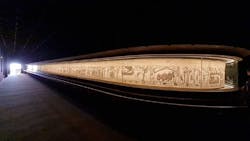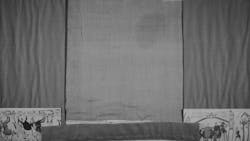S-MA-C-H has developed a machine vision system for use in examination and preservation of historic textiles.
S-MA-C-H (Sainte-Cecile-Les-Vignes, France) is a French startup that focuses on using mechanical engineering techniques in the study and preservation of art and cultural heritage assets. The Normandy Regional Office of Cultural Affairs commissioned S-MA-C-H to study the Bayeux Tapestry, a 231-foot long by 20-inch tall narrative embroidery textile artifact that tells the story of William of Normandy’s conquest of England. It is believed to have been created during the 11th century. Textiles, especially an artifact as old as the Bayeux Tapestry, can be difficult to work with because they are inherently delicate and therefore extremely susceptible to damage not only from long-term deterioration but in handling, even by the most careful and knowledgeable of experts.
The team, headed by S-MA-C-H Founder Cecelia Gauvin, wanted to study this delicate and one-of-a-kind artifact without damaging it to determine if there is an optimal way to position the tapestry for display with minimal to no damage, as well as find out what, if any, effect the microclimate—the atmosphere within the space in which the artifact is displayed or stored—had on the tapestry. In order to accomplish this, the team needed to develop an inspection system that not only monitored temperature, humidity and gravity pressure on the tapestry, but could utilize machine vision technology to inspect and record images of the tapestry.
(Read more about how machine vision is being used in cultural and historic preservation applications here.)
Modern Automated Vision Technology Meets Ancient History
For the machine vision inspection aspect of the system, the team used non-contact 2D full-field digital image correlation (DIC), an image processing technique that requires capturing high-resolution images, then evaluating those images using software algorithms to detect changes in the shape, position or size of the material being recorded.
The team used a C-mount USB 3 uEye CP 3800 line scan camera from Imaging Development Systems (IDS; Obersulm, Germany). The camera has a Sony Starvis series CMOS rolling shutter, is rated at IP30, has an optical area of 12.286 x 8.861 mm, and a frame rate at resolution max of up to 19.5 fps. The camera is capable of 5536 x 3692 (h x v) resolution, and 20.44 MPixel resolution, with a 2.40 µm pixel size. The camera also is equipped with backlit technology.
With this system, the team could conduct their visual inspection scans in very low light conditions, which is important in the preservation of delicate artifacts, Gauvin said. Once the team had fine-tuned the system by testing it on facsimile artifacts, they could effectively deploy it to study the Bayeux Tapestry.
The Pprime Institute, a research group from Poitiers University (Poitiers, France), developed the software used in the inspection process, which was specifically designed for digital image correlation, Gauvin says.
During the process, the camera was mounted on a tripod with a three-axis head for ease of mobility. The team used a calibration plate to calculate the 2D position of the camera in relation to the object—in this case the tapestry itself—and correct any distortion caused by the camera and lens.
The monitoring process had to be performed in low light to preserve the tapestry, so the team captured ultra high-resolution images at low frequency; in fact, they monitored the tapestry 24 hours a day for a month, taking only one image per hour. Once they had the images they needed, the team then processed the images using the software. This provided full-surface measurement data of the tapestry, based on thousands of high resolution 2D or 3D coordinates.
For this study, the team used an external light source, an LED panel that was programmed to turn on only during the shots, Gauvin says.
“But in other situations, such as when we’re working in certain museums, we can’t add external light sources at all. That’s why the sensor must have a good sensitivity to light.”
Gauvin explains that the displacement of the image points within the examination period is interpreted as a deformation caused by a mechanical load or stress on the object. Based on these results, the team could generate full-field strain maps, which illustrate whether and how an object (in this case the Bayeux Tapestry) has deformed or deteriorated, as well as deformation maps, which show local deformations in a given material.
With the information from the full-field strain maps and the environmental variation findings, the team could better understand the interplay between moisture and the mechanical properties of the textile and thus could make informed best practices recommendations for display and storage of the tapestry.
What Happens Next
The study was successful in gathering the data necessary for the team to make best practice recommendations, Gauvin says. They have forwarded their findings and recommendations to the various stakeholders, including the Normandy Regional Office of Cultural Affairs. In addition, the team plans to publish their results with the ICOM-CC (International Council of Museums International Committee for Conservation), an organization that is dedicated to education, connection, and furthering the missions of museums worldwide.
One of the goals of S-MA-C-H is to develop similar systems, in a plug-and-play format, for conservators and historic preservationists working in other areas and facilities. Indeed, such functions as monitoring damage to paintings in museums, or to historical monuments exposed to the elements, are areas that could benefit greatly from machine vision, Gauvin says.
“The monitoring technique using machine vision we used for the tapestry is a service that my company offers to museums and art holders,” Gauvin says. "Our knowledge of mechanical engineering, combined with industrial image processing, opens up new approaches, expands the range of actions and produces innovative solutions.”
About the Author
Jim Tatum
Senior Editor
VSD Senior Editor Jim Tatum has more than 25 years experience in print and digital journalism, covering business/industry/economic development issues, regional and local government/regulatory issues, and more. In 2019, he transitioned from newspapers to business media full time, joining VSD in 2023.


